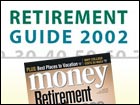
It's a great time to be young. Not only are your savings helping to make up for losses, but you also have enough time to bounce back, especially because what you've saved so far is only a fraction of what you will save.
According to a study by TIAA-CREF, if someone starts saving at 25, the amount he has saved by age 30 would represent about 17 percent of his portfolio at age 65. A 20 percent hit when he's 30 would amount to only a 3 percent decrease in the value of his portfolio at age 65.
"Since the 30-year-old hasn't made all his money yet, he can't lose it," says Martin Leibowitz, chief investment officer at TIAA-CREF. Even for 40-year-olds, who've saved nearly 50 percent of what they'll have at age 65, that 20 percent hit would produce only a 10 percent shortfall -- damage that can be repaired with extra savings and smart strategies.
Reaching your retirement goal hinges on how much you save in the years to come, and that rate will have to be vigorous. Here's a plan for getting where you want to be.
Recalculate your needs Of course, there is no fool proof method for figuring out exactly what you'll need, and no expert can predict what the market will do in the next 20 years. But simply assessing where you stand, creating realistic targets and devising strategies may improve your odds of success.
A recent study from the Center for Retirement Research at Boston College found that households in which someone thought "a lot" about retirement had twice as much wealth heading into the golden years as households in which there was little or no planning.
Making such calculations in recent years, you might have overstated just how much your savings would grow. Now, are you ready for returns on stocks of maybe 7 percent or 8 percent? Use our Retirement Planner and Savings Calculator to gauge how much you might need, and your chances of getting there.
Get help at work At this point, you may be faced with a harsh reality: You need to save more.
Fortunately, Congress has given you some help. Employees can now put as much as $11,000 in their 401(k), 403(b) and 457 plans, up from $10,500 in 2001. That cap increases by $1,000 each year until 2006 and is adjusted for inflation thereafter. Self-employed workers can put significantly more away as well.
These higher caps can make a big difference. A 45-year-old who takes advantage of the higher limits every year will end up with almost $200,000 more (before taxes) at age 65, assuming an 8 percent average annual return, according to calculations by T. Rowe Price.
Note that the new limits are voluntary. If your employer decides against raising them, you're stuck. Fortunately, according to benefits consulting firm Watson Wyatt, early indications are that most companies will start using the new limits this year.
Look to IRAs Once you've put away as much as you can on the job, see if you can take advantage of the new IRA rules.
Contribution limits to both traditional and Roth IRAs have jumped from $2,000 a year to $3,000 in 2002 and will reach $5,000 in 2008. Just as with 401(k)s, this increase can make a big difference. After 20 years, an IRA investor could now rack up $248,800 instead of $126,000.
| |
 Retirement Toolkit
Retirement Toolkit
| |
| | |
| | |
|
(Deductible IRAs are still subject to restrictions -- single employees making more than $34,000 and married couples earning a combined $54,000 do not qualify for the full deduction. To fully fund a Roth, couples can have adjusted gross income no more than $150,000, singles no more than $95,000.)
Beware of tax traps States have until the end of the year to decide whether they will go along with the increased limits; some, including New Jersey, Pennsylvania and Wisconsin, haven't made their choice clear. Investors in those states could find that what the federal government considers a pretax 401(k) or IRA contribution is taxable income on a state tax return.
"All of a sudden we've got something that's federally deductible but not state deductible," says Donn Sharer, a vice president of MetLife financial services. "It could be a real mess." (See more on this potential tax trap -- click here.)
Save more after tax As fabulous as the new contribution limits are, the reality is that putting every possible penny into tax-deferred retirement plans will not be enough. According to projections from Fidelity, mid-career workers can expect 401(k)s to contribute only 55 percent of the income they'll need to retire.
The message is clear: To retire well, you need additional savings. Scott Lummer, pension investment consultant and former Ibbotson strategist, advises squirreling away 15 percent to 20 percent of your gross income toward retirement during these accumulation years. That may seem like a tall order, but it's a lot easier than the 25 percent or more that might be required later.
Invest for growth From your twenties through your forties, investing for growth is crucial. For many people, an appropriate asset allocation would be 80 percent stocks and 20 percent bonds, with most of the stock money going into a broad index fund and the rest into small-company and international stocks.
Finally, keep an eye out for tax efficiencies in the money you save on your own. Index funds, low-turnover mutual funds and, for what little bond exposure you may have, muni bonds and muni bond funds always give a boost to your taxable retirement savings. (For a list of tax-efficient mutual funds, click here.)

|

